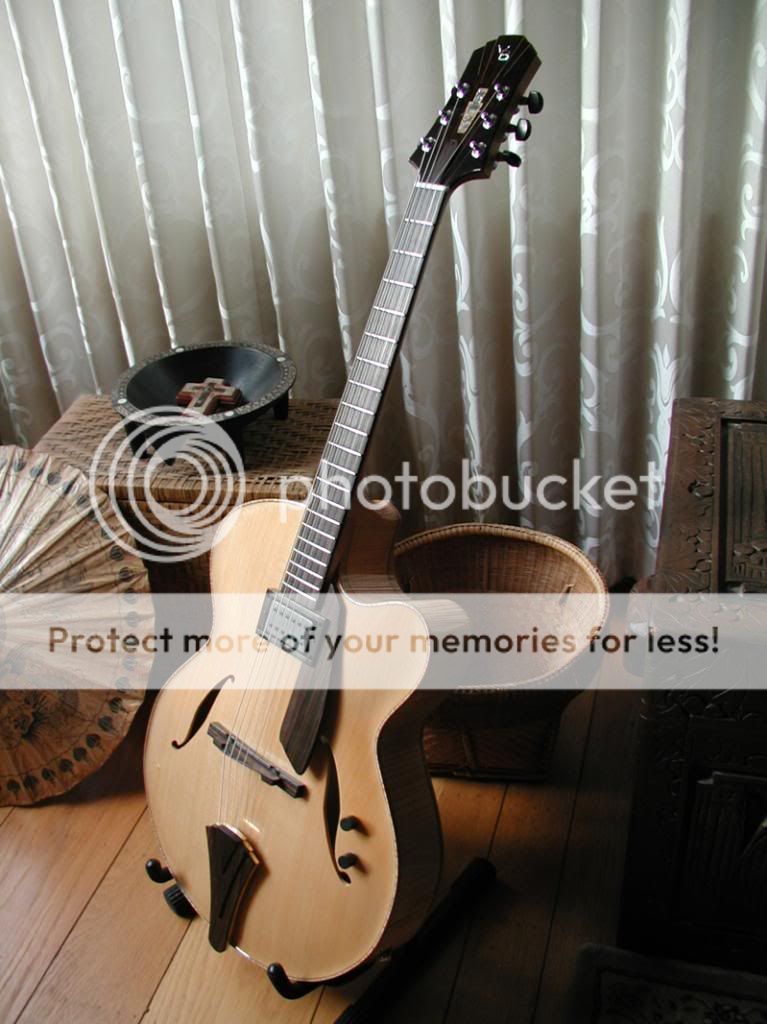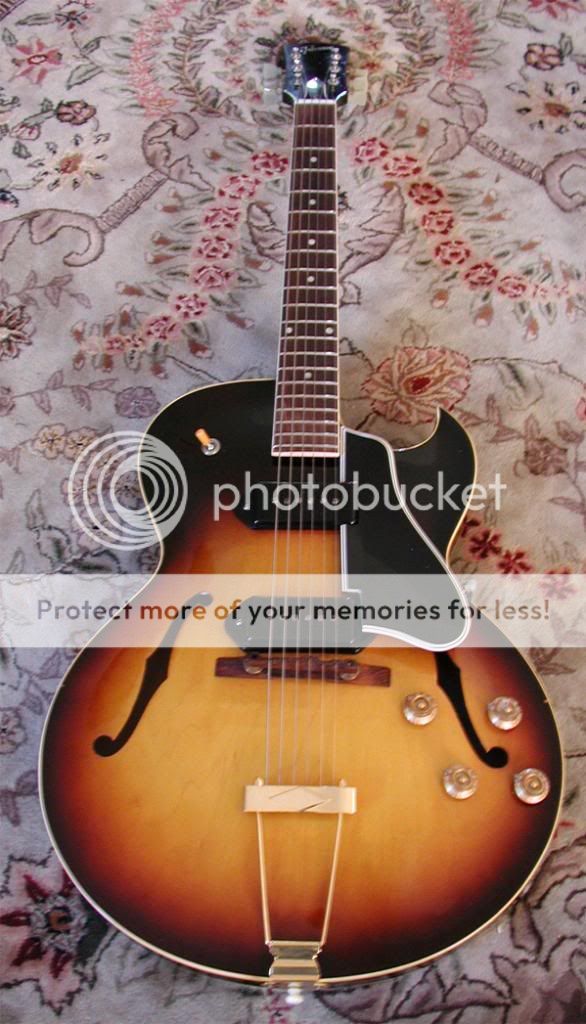DustyCat
Hero Member
- Messages
- 853
Thank you for your interest in this topic. Here goes nothin... :doh:
I am so happy with my latest Warmoth combination of electric guitar neck and electric guitar body parts, that I could not help but think how and why this new guitar pleases me so much more than many of my others (including my first Warmoth Strath Spring 2005 which needs to be refretted/new neck/tremsetter etc.). This train of thought went beyond quality of construction, personal customization, tone, aesthetics, affordability and ultimately led to playability and comfort. Not just how a guitar should play, but how I should feel when playing electric guitar. No, forget "me" how my body should feel when playing my instrument.
Much of the physical nature required of the left hand to "fret" or "finger" notes, doublestops, triads or chords (open, barre, 7th, Jazz, Tetra etc.) requires some form of grabbing and/or closing of the hand.
A cup or glass might be a good example or something common that everyone could hopefully easily obtain which should fit very easily in their hand.

Notice the direction the thumb points when it grabs.
Also take notice of how much hand strength you might be able to apply. You might assign yourself a percentage of the total available amount of hand strength you might be able to apply such as 100% or less than 100% should you decide to do so. For now however, let the cup or similar held object, rest in your hand, and instead imagine what percentage of potential strength you might be able to bring to bear when closing your hand.
Now...to speed things up a little and get right to the point...notice the direction the thumb points when grasping the neck of a guitar while playing a barre chord.

In this picture I am fretting a simple F Major Barre Chord in 1st position. My thumb is pointing in the opposite direction!
Hand strength is greatly reduced because the thumb is unable to leverage the full strength of the muscle to bear. Prolonged exertion of the thumb in this UN-ergonomic position may lead to cramps and or pain. This happened to me just this morning when I was playing along to "Dani California" of which I had played live before. My hand was cramping up unexpectedly, and causing me pain. I thought to myself 'Nevermind the pain, this is going to be embarrassing if someone asks me to play for them, and I can barely hold onto these power chords while crying like a little girl because I am in so much pain.' It might not have been until 10-15 minutes until the pain subsided (after some massaging) but playing barre chords and power chords still felt very awkward because of the pressure exerted on my thumb. Not just the pain, but the inability to bring the full strength of my hand to bear to maintain the necessary pressure to hold the strings down in these chord shapes (5ths & Octaves).
Here is a picture demonstrating the amount of space between the neck (1 11/16" width nut, Wolfgang back contour, 6100, Full Scallop) and my thumb while holding an open "D" chord.

To emphasize this point, of jamming the thumb into an uncomfortable position, here is a picture I took earlier today playing a commonly known "F9" chord in root position, while holding a lacrosse ball in the same hand.

I was able to successfully strum and pluck the notes of the chord while holding the lacrosse ball in the same hand.
This picture was taken with the neck of my new Warmoth guitar resting in the crook of my thumb in the same way the thumb should want to close naturally.

If *ALL* of the space between the tips of my fingers and the neck/fingerboard were filled with wood it would be difficult to wrap my fingers around, but still there is much room left.
Case in point, I think that maybe if some of the space were filled in with a thick, fatter neck (but still asymmetrical back contour for greater ergonomics) these barre chords would be easier to play.
Well, I hope they were only cramps in the muscles around my thumb, but time and time again, and especially with true acoustic guitars, it just seems like I'm not getting full power out of my hand strength because of the way my thumb is contorted from the necessary pressure required to play barre chords
Anybody else experiencing this? I've been playing for like 17 years, Berklee College of Music Alumni 2006. Maybe you have some solutions or ideas...
I counter the "So don't play guitar" or "So don't play barre chords" with I LIKE playing guitar and I like playing barre chords :icon_tongue:, except for the cramps and the :sad: pain (See Blue, Yellow, and/or White):
http://www.eatonhand.com/mus/mus131.htm
Thanks again for your time. I wasn't sure who to present this to as many of my former professors are busy with their own work, many of my musician friends have families or are similarly busy, and no one in my family plays guitar and doesn't really understand. And after those 10-15 minutes (first 3 songs) my hand did feel better and I could play without pain, but still with a squashed thumb :icon_scratch:
-Steve
P.S. Since when did barre chords get so hard to play? seriously...
I am so happy with my latest Warmoth combination of electric guitar neck and electric guitar body parts, that I could not help but think how and why this new guitar pleases me so much more than many of my others (including my first Warmoth Strath Spring 2005 which needs to be refretted/new neck/tremsetter etc.). This train of thought went beyond quality of construction, personal customization, tone, aesthetics, affordability and ultimately led to playability and comfort. Not just how a guitar should play, but how I should feel when playing electric guitar. No, forget "me" how my body should feel when playing my instrument.
Much of the physical nature required of the left hand to "fret" or "finger" notes, doublestops, triads or chords (open, barre, 7th, Jazz, Tetra etc.) requires some form of grabbing and/or closing of the hand.
A cup or glass might be a good example or something common that everyone could hopefully easily obtain which should fit very easily in their hand.

Notice the direction the thumb points when it grabs.
Also take notice of how much hand strength you might be able to apply. You might assign yourself a percentage of the total available amount of hand strength you might be able to apply such as 100% or less than 100% should you decide to do so. For now however, let the cup or similar held object, rest in your hand, and instead imagine what percentage of potential strength you might be able to bring to bear when closing your hand.
Now...to speed things up a little and get right to the point...notice the direction the thumb points when grasping the neck of a guitar while playing a barre chord.

In this picture I am fretting a simple F Major Barre Chord in 1st position. My thumb is pointing in the opposite direction!
Hand strength is greatly reduced because the thumb is unable to leverage the full strength of the muscle to bear. Prolonged exertion of the thumb in this UN-ergonomic position may lead to cramps and or pain. This happened to me just this morning when I was playing along to "Dani California" of which I had played live before. My hand was cramping up unexpectedly, and causing me pain. I thought to myself 'Nevermind the pain, this is going to be embarrassing if someone asks me to play for them, and I can barely hold onto these power chords while crying like a little girl because I am in so much pain.' It might not have been until 10-15 minutes until the pain subsided (after some massaging) but playing barre chords and power chords still felt very awkward because of the pressure exerted on my thumb. Not just the pain, but the inability to bring the full strength of my hand to bear to maintain the necessary pressure to hold the strings down in these chord shapes (5ths & Octaves).
Here is a picture demonstrating the amount of space between the neck (1 11/16" width nut, Wolfgang back contour, 6100, Full Scallop) and my thumb while holding an open "D" chord.

To emphasize this point, of jamming the thumb into an uncomfortable position, here is a picture I took earlier today playing a commonly known "F9" chord in root position, while holding a lacrosse ball in the same hand.

I was able to successfully strum and pluck the notes of the chord while holding the lacrosse ball in the same hand.
This picture was taken with the neck of my new Warmoth guitar resting in the crook of my thumb in the same way the thumb should want to close naturally.

If *ALL* of the space between the tips of my fingers and the neck/fingerboard were filled with wood it would be difficult to wrap my fingers around, but still there is much room left.
Case in point, I think that maybe if some of the space were filled in with a thick, fatter neck (but still asymmetrical back contour for greater ergonomics) these barre chords would be easier to play.
Well, I hope they were only cramps in the muscles around my thumb, but time and time again, and especially with true acoustic guitars, it just seems like I'm not getting full power out of my hand strength because of the way my thumb is contorted from the necessary pressure required to play barre chords
Anybody else experiencing this? I've been playing for like 17 years, Berklee College of Music Alumni 2006. Maybe you have some solutions or ideas...
I counter the "So don't play guitar" or "So don't play barre chords" with I LIKE playing guitar and I like playing barre chords :icon_tongue:, except for the cramps and the :sad: pain (See Blue, Yellow, and/or White):
http://www.eatonhand.com/mus/mus131.htm
Thanks again for your time. I wasn't sure who to present this to as many of my former professors are busy with their own work, many of my musician friends have families or are similarly busy, and no one in my family plays guitar and doesn't really understand. And after those 10-15 minutes (first 3 songs) my hand did feel better and I could play without pain, but still with a squashed thumb :icon_scratch:
-Steve
P.S. Since when did barre chords get so hard to play? seriously...




